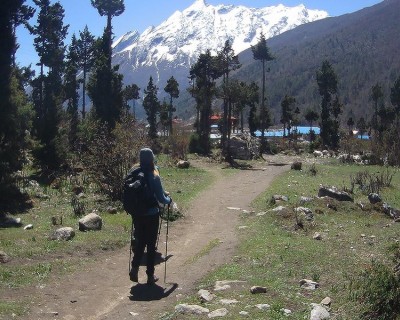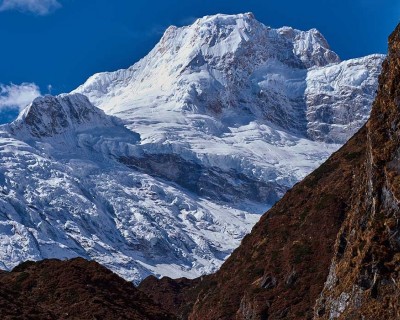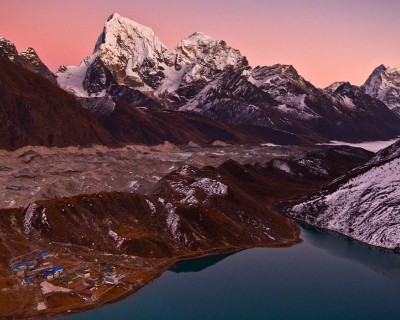.jpg)
Is Kanchenjunga for Beginners? | Understanding Kanchenjunga Trek
Kanchenjunga Trek is a wonderful journey in the far eastern part of Nepal. Due to its isolation, which has helped to conserve the natural beauty of the region to its pure state, you will be able to secure a tranquil Himalayan experience.
Similarly, the route also follows the path across the traditional ancient settlements, which will provide you insights into the high-altitude lifestyle. Your journey on the standard route of the region starts after a flight from Kathmandu (1,400m) to Bhadrapur (91m).
Proceeding further in the route, you will drive to Taplejung (1,820m) from Phidim (1,365m), which will be the official trek starting point. You will then slowly walk on the gradually ascending route from Sinuwa (980m) across Tapethok (1,380m), Amjilosa (2,310m), and Gyabla (2,730m) to reach Ghunsa (3,595m).
You will take an acclimatization day at Ghunsa before continuing toward Kanchenjunga North Base Camp (5,065m) across Khambachen (4,000m) and Lhonak (4,780m). After completing the exploration of the base camp, you will retrace your steps across Lhonak and Khambachen, heading toward Phaley (3,240m).
Then, continuing on the same route, you will head down to reach Taplejung. From here, you will drive back to Bhdarapur and take the return flight to Kathmandu.
Note: This is a standard Kanchenjunga Trek route. If you want to enjoy an extensive journey, you can also use the Kanchenjunga Circuit Trek option.
Challenges of Kanchenjunga Trek
After understanding the nature of the Kanchenjunga Trek, let’s move on to the part about the overall difficulty level of the trek. In general, the Kanchenjunga Trek difficulty is at a moderate scale.
There aren’t any significantly challenging parts nor any technical parts in the route. Thus, overcoming the mild aspects of the difficulty won’t be a hurdle, even if you are a complete beginner. Let’s check out the major component that influence the Kanchenjunga Trek difficulty.
Altitude Gain and Acclimatization
As the overall altitude gain in this off-beaten route is quite significant, altitude gain can be considered one of the major hurdles of the Kanchenjunga Trek difficulty. You will start your trek from Taplejung (1,820m).
Gradually pacing yourself on the ascending route, you will reach the maximum point at Kanchenjunga North Base Camp (5,065m). So, the overall altitude gain on the route will be approximately 3,245m (10,646ft).
Acclimatizing properly is very important in this trek to avoid any kind of risks that come along with altitude sickness.
Off the Beaten Route
Kanchenjunga Trek map navigates the rough and remote parts of the eastern Himalayan region. If you have not done any high-altitude treks in Nepal, the mountain routes are generally a mixture of loose soil, gravel, rocky, boulder, and icy moraines of glaciers.
The total trekking distance for this adventure is around 170 to 220 km (105 to 136 miles), depending on the route and the highlight exploration of the region. You will have to walk around 6 to 7 hours on average during the trekking days of this journey.
Thus, taking on the rugged mountain terrain that is gradually pushing to higher altitudes is not easy to accomplish without good preparation.
Remote Location
Another factor of the Kanchenjunga Trek difficulty you have to be prepared for is the remote nature of the trip. The Kanchenjunga Trek route stretches across some of the most secluded and less crowded parts of the Himalayas.
Due to a lack of proper development, the available services here are not on par with those in urban vacation destinations. The food and accommodation facilities available on this route are on a standard level.
But, for other amenities such as transportation, health facilities, internet, hot showers, means of telecommunication, etc, they are limited in number. Thus, although this route rewards you with a serene experience, you will still have to mentally prepare for the remoteness aspects of the journey to avoid disappointments.
Weather Conditions
After understanding the major factors that influence the overall Kanchenjunga Trek difficulty, you also have to be careful about which season you are doing this trek in. Depending on the period you choose for the trek will affect the scale of the difficulty aspect.
If you do this trek during the peak seasons, such as spring (March to May) and autumn (September to November), you will be able to secure a comfortable experience. As the weather conditions are favorable, you will not have to deal with any extra weather-related phenomena.
However, if you schedule this for off periods like monsoon (June to August) and winter (December to February), you will need to deal with challenges presented by the weather.
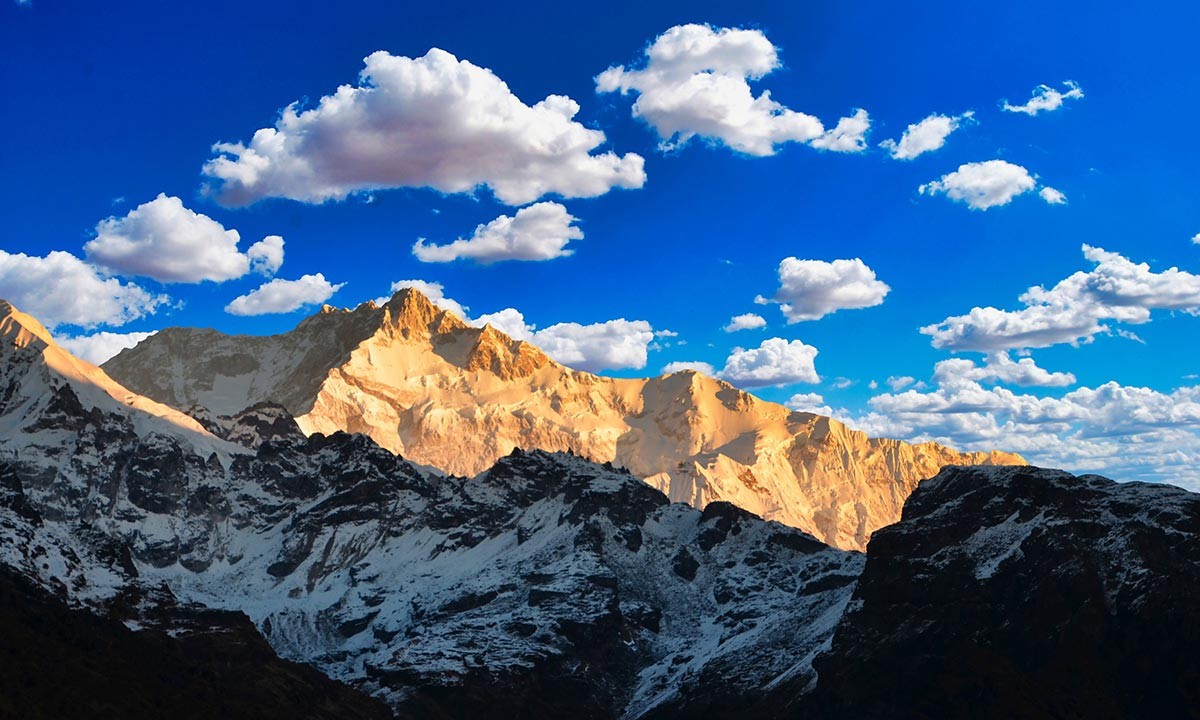
Essential Preparation for Beginners
To secure a sweet Kanchenjunga Trek for beginners experience, you need to make an adequate level of preparation. If you are prepared enough, the difficulty aspects of this journey will not be that challenging.
Here are some efficient preparation methods that expert guides suggest to the trekkers who are doing high-altitude treks for the first time.
Physical Preparation
It is important to craft an efficient training program and stick to it if you are looking forward to a comfortable experience. Even if you don’t have any experience in high-altitude treks, a good level of physical preparation will compensate for the lack of experience.
You don’t need to strive for the top shape; however, you will definitely need to stay consistent with your training schedules. In general, for the high altitude and long-duration treks in Nepal, you will have to train for a minimum of 3 to 6 weeks.
Depending on your physical capabilities and fitness level, you can also extend or reduce the training period. Your main priority for the training should be developing stamina, strength, and endurance.
If you focus on core strength, it will also help you balance yourself on uneven mountain roads. Staying consistent with the training will make long hours of walking on demanding trails possible, even if you are not that physically active.
Note: Experts suggest that if you do some practice hikes around the steep slopes, it will help you understand the mountain trail and specific areas you have to improve for your trek. P.S. You will also have the opportunity to test out your gear.
Mental Preparation
All the trekkers know the importance of physical preparation and how impactful it is to mitigate the difficult level of any adventure. However, many trekkers also tend to overlook the mental preparation part.
If you are doing Kanchenjunga Trek as beginners, you shouldn’t overlook the mental preparation part. The experienced trekkers are already familiar with the remoteness part of the journey, and they are well adapted to the physical exhaustion along the route as well.
However, for a complete beginner, dealing with these factors can be difficult if they are not mentally prepared. So, besides being determined to complete the journey and staying motivated, there are a few factors that you need to consider for the mental preparation part.
Helpful Tips for Mental Preparation
- Visualize your journey and the difficult aspects you will have to encounter
- Develop a positive mindset and set realistic goals
- Practice staying calm, composed, and being patient
- Be flexible and learn to leave your comfort zone
- Visualize your success
- Practice focused breathing and meditation
- Understand your limits and don’t be too hard on yourself
Pack Necessary Trekking Gear and Equipment
During high-altitude treks in Nepal, you will traverse across multiple climatic zones. Thus, it is important to be well-prepared for your journey in Nepal, especially so if you don’t understand what climate variation feels like.
You will get started on this off-beaten trail from the tropical zone (below 1,000 meters) and push all the way to the trans-Himalayan zone (above 5,000 meters). The temperatures in the lower regions are generally warmer; however, as you ascend higher, they start to drop gradually.
So, need to stick with a proper layering system and prepare for the cold, high alpine temperatures. Similarly, depending on the season you are planning Kanchenjunga Trek for beginners, you will need season-specific gear as well.
If you do this trek during the peak periods (autumn and spring), you will be able to get by with standard layers and gear. As for the winter trek, your focus should be on warm and buff layers, whereas for the monsoon endeavor, you need to emphasize waterproof components.
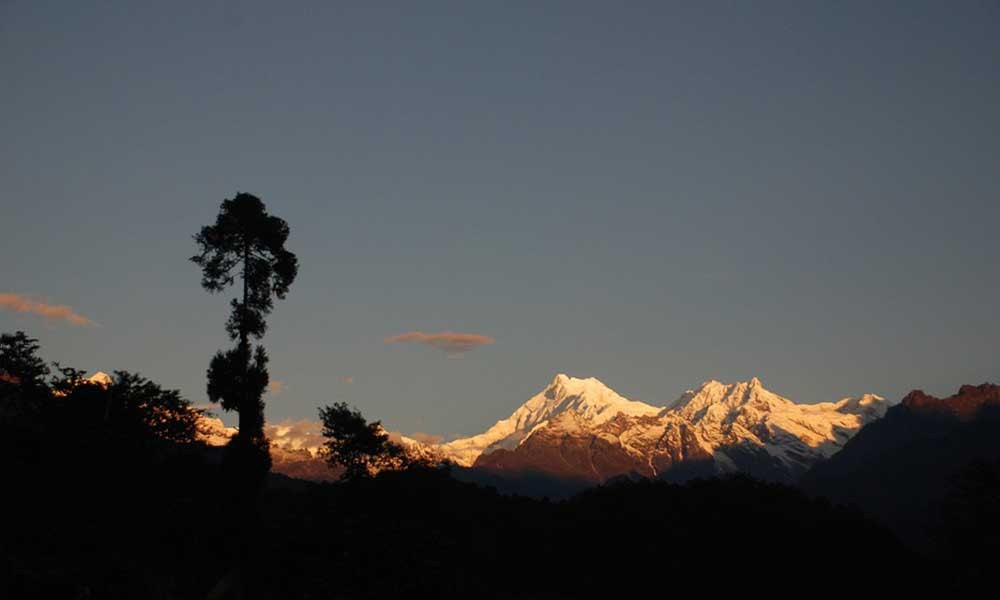
Do Kanchenjunga Trek Nepal During Spring or Autumn
Kanchenjunga Trek for beginners is always suggested during one of the peak trekking periods. If you do this trek during either autumn (September to November) or spring (March to May), you will be able to comfortably enjoy your trip.
Both of these seasons are popular for weather stability and offer the most appropriate period for adventures in the Himalayas. If you do Kanchenjunga Trek during one of these seasons, you will also not need to deal with the added difficulty level due to the unfavorable climate.
Besides, both spring and autumn have exceptional highlights. Spring is famous as the haven of nature, and you will see colorful visuals no matter where you look. The pristine mountain views over the lush and stunning landscape will make your journey feel magical.
Similarly, autumn is considered the ultimate season of calm and stability. You will not need to worry about any weather-related challenges during this trek, and you will be able to walk comfortably on the dry-easy trails.
Autumn is also popular for its crisp temperatures that are just right for outdoor ventures. Due to stable weather, the clear days reward trekkers with exceptional mountain views. You can also expect a great level of cultural immersion during this period, as autumn is a core period for the biggest festivals in the country.
Importance of Acclimatization Days
Acclimatization/rest days are very crucial when taking part in long endeavors. These rest periods present enough time for acclimatizing that you don’t have to be anxious about the risk of altitude sickness during your trip.
Likely, during the long-haul journey, the acclimatization days also present an ample opportunity to get your much-deserved proper rest. So, before taking on any Kanchenjunga Trek for beginners, you need to properly assess these aspects.
Marvel Adventure’s Kanchenjunga Circuit Trek follows a proper acclimatization process along the route. You will also get enough rest period during your trek, so you don’t have to worry about completely draining yourself.
Conclusion
As you have learned a lot of aspects about the Kanchenjunga Trek for beginners, you now have insights into the overall journey and its challenging factors. So, to draw a conclusion on the topic of is Kanchenjunga for beginners, the answer is Yes!
Despite being a long and high-altitude journey, the difficult factors of the Kanchenjunga Trek are still on a milder scale. You don’t have to push for significant altitude on this trip, and you will follow a steady pace during every trekking day.
So, if you are a Himalayan trekking enthusiast and don’t mind sticking with the Kanchenjunga Guide module, this tranquil journey on the isolated part of the Himalayas won’t be that much of a challenge for you.
Also, Marvel Adventures will manage everything and take care of your health, pace, comfort, safety, and well-being during the trip. So, you don’t have to worry about anything and you can just focus on making the best out of your journey.
Even as a beginner, you will not have to worry about anything while trekking with us. We will custom-tailor suitable itinerary plans for you, considering the required rest period, acclimatization time, walking pace, and your comfort.
Thus, even if you are completely new to the high-altitude treks, your journey with Marvel Adventure will be a smooth and seamless experience.
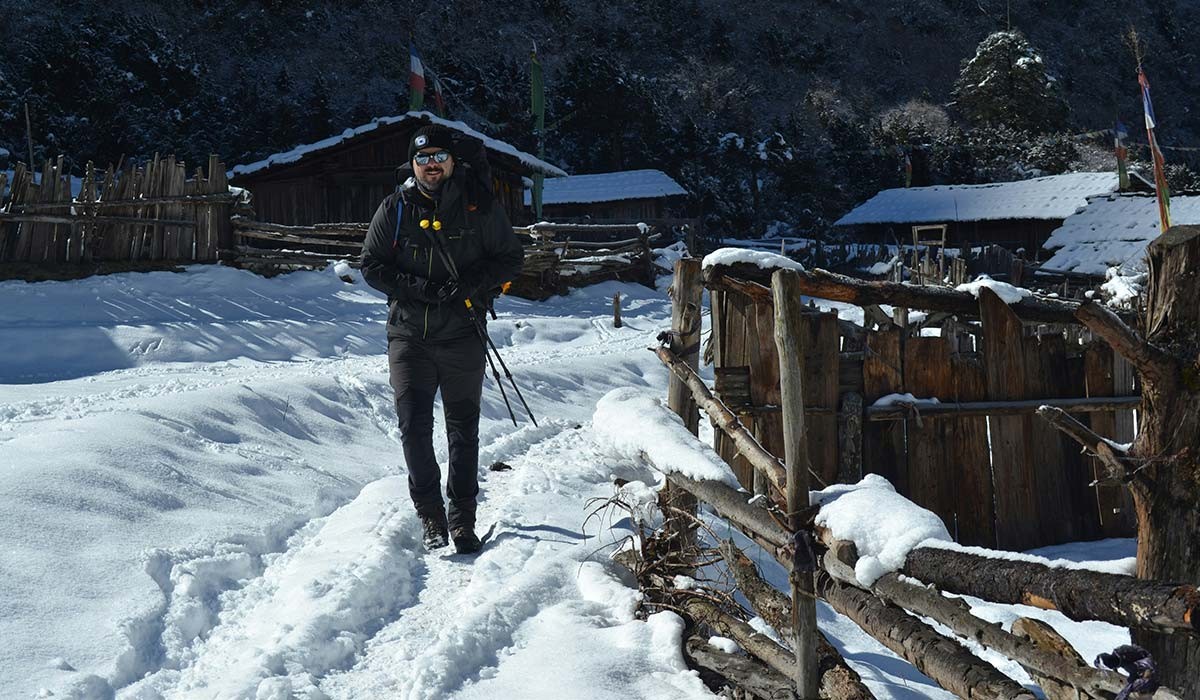


.jpg)


